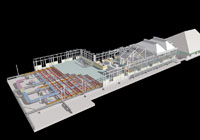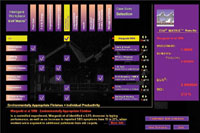

The Center for Building Performance and Diagnostics (CBPD)
Carnegie Mellon University
A National Science Foundation Industry/University Cooperative Research Center since 1992
High-performance buildings enhance worker effectiveness and productivity through improved health, communication, and comfort.

|
Center Mission and Rationale
The Center for Building Performance and Diagnostics (CBPD) conducts research, development, and demonstrations to increase the quality of and user satisfaction with commercial buildings and integrated building systems, while improving cost, time, and energy-efficiency. High-performance buildings must provide appropriate physical, environmental, and organizational settings to accommodate changing technologies and workplace activities. The Center's members are prominent leaders in the market for high-performance buildings.
The main goals of CBPD are to --
- Study international developments in high-performance buildings. (CBPD has built an international knowledge base on advanced office buildings in Canada, Germany, Japan, the Netherlands, the United Kingdom, the United States, and France.)
- Develop innovative products. (CBPD has developed a list of major design features and decisions that are critical to the advanced office.)
- Develop an innovative building delivery process centered on a team approach to design. (The center has developed guidelines for high performance buildings.)
- Improve educational curricula and materials on systems integration for building performance. (The Center continues to graduate PhD and Masters Students who become leaders in industry, the professions, and industry here and abroad.)
- Designed and constructed the Intelligent Workplace. (The Robert L. Preger(TM) Intelligent Workplace has won international and national awards, i.e. the Merit Award by the American Institute of Steel Construction [2001]; the Honor Award for Architecture and Design by the AIA [1999]; the Business Week/Architectural Record Award [1999]; the Three Rivers Environment Award in Higher Education [1996].)
- Complete state-of-the-art demonstration projects. (In 2001, the Center was a key partner in creating the Laboratory for the Design of Cognition at the Electricite de France in Paris.)
- Complete a "breakthrough building" with a private owner or developer. (The Center introduced cost effective high-performance concepts into developer built projects, as well as buildings of State and Federal Agencies.)
The demonstration projects further introduce CBPD findings into the mainstream practices of the building industry.

|
Research Program
CBPD's investigators have performed significant research in the area of building performance and diagnostics. Selected research activities include --
- Major performance-design decisions for offices, courthouses, and university laboratories
- Energy-efficient revitalization of inner-city housing
- Impact of HVAC, lighting, and enclosure zoning and control on the energy consumption of commercial buildings
- Development of integrated computational design and simulation environments for concurrent performance analysis
- Long-term analysis of the thermal, visual, and acoustical performance of buffer spaces (e.g., atria)
- Studies of daylight/electric light interfaces and development of an expert system to simulate and evaluate the visual quality of indoor rooms
- Empirical assessment and computer simulation of sound transmission between adjacent spaces
- Development of web-based Guidelines for High Performance Buildings (employed by the U.S. Department of State for the design and engineering of new U.S. Embassies and Consular facilities)
- Development of a web-based interactive Building Investment Decision Support Tool (BIDS) aimed at CFO- and CEO-level decision makers
- The Building as Power Plant/Intelligent Workplace(TM) Energy Systems, which seeks to integrate advanced energy-efficient building technologies with innovative distributed energy generation systems.
The CBPD research program has several distinguishing characteristics. The Center contends that occupied buildings are the most reliable validation field for the performance of individual components and their impact on occupants (as opposed to the study of one building-performance issue in isolation from others in a "conventional" laboratory setting).

|
Additionally, CBPD guidelines and practices depart radically from the standard linear process of building delivery and patchwork integration of building systems. The Center advocates a team decision-making process for building design and delivery, starting with an explicit recognition of the performance needs of occupants. This process ensures more fully integrated building design and engineering that provide environmental quality and respond to evolving technologies and the dynamic needs of occupants.
Finally, CBPD research involves an in-depth analysis of interactions and interrelationships between different building-performance descriptors and building systems.
Special Center Activities
In cooperation with the Advanced Building Systems Integration Consortium (ABSIC), which serves as the Center's Industrial Advisory Board, CBPD researchers are carrying out a series of demonstration projects designed to progressively introduce CBPD's research findings into the mainstream building industry. The Robert L. Preger Intelligent Workplace(TM), first occupied in December 1997, was the first in this series of demonstration projects and satisfies the need for a dedicated research environment that addresses the necessity of integrative building-performance evaluation. This facility not only houses center faculty, staff, and Ph.D. students, along with building performance and diagnostics instrumentation, but also is the subject of building performance research. The facility functions as a dynamic laboratory and a high-performance computing workplace. The Intelligent Workplace(TM) assimilates experimental design innovations and high-performance products and assemblies into all building systems (enclosure, mechanical, telecommunications, electrical, and interior systems). Since its official opening, several thousand visitors have taken guided tours through the R&D facility.
CBPD research and development activities have fostered several collaborative efforts between sponsor companies to develop improved building products and systems. One example of the Consortium's responsiveness to innovative design directions for industry is the Personal Environments Module(TM) (or PEM(TM)), which was developed by Johnson Controls Inc. and the CBPD. The PEM(TM) allows for greater individual environmental control by ducting fresh air to each workstation and permitting the occupant to control air speed, temperature, and direction, along with other environmental factors.

|
The Center's corporate sponsors include major U.S. construction companies (with worldwide operations) along with manufacturers of instrumentation, controls, telephone and lighting equipment, and software. U.S. Federal government sponsors include the Department of Defense, the Department of Energy, the Environmental Protection Agency, the Department of State, and the General Services Administration. Public Works and Governmental Services Canada has become a member of ABSIC. The Center has several European companies as partners, as well as the Dutch Building Agency.
Other accomplishments of the Center are highlighted below:
- The CBPD offers the only program in the United States with a graduate concentration in building performance and diagnostics.
- The CBPD received an Honor Award for Architecture and Design for the design of the Intelligent Workplace(TM). This is the highest National Award Category given by the American Institute of Architects, May 1999.
- The CBPD was awarded the Three Rivers Environmental Award in 1996, recognizing its excellence in advancing environmental quality in Western Pennsylvania.
- The American Institute of Architecture Students (AIA) named the CBP&D faculty member, Vivian Loftness, Head, School of Archiectures, "The 2001 National Educator of the Year."
Another project that features Intelligent Workplace technologies and energy conservation measures is the 73,000 sq. ft. Department of Environmental Protection (DEP), Commonwealth of Pennsylvania, Region 3 Headquarters Building.
In close cooperation with the U.S. General Services Administration, the Adaptable Workplace Laboratory, a 15,000-sq.-ft. rehabilitation of one floor of one wing of the GSA Headquarters, was realized using the principles and concepts developed at the center.
The center has contributed key concepts to the Owens Corning Headquarters, Toledo, OH, in cooperation with the office of Cesar Pelli, Architects and Gerald Hines, Developer. Additional projects with Center involvement are ongoing or completed in Seoul, Korea; Germany; France; and North America.
Center Headquarters
Center for Building Performance and Diagnostics (CBPD)
Carnegie Mellon University
Pittsburgh, PA 15213
Tel (412) 268-2350 * Fax (412) 268-6129
Homepage: www.arc.cmu.edu/cbpd/
Center Director: Dr. Volker Hartkopf
hartkopf@cmu.edu
Center Evaluator: Dr. Paul Fischbeck
(512) 268-3240
NSF 01-168u